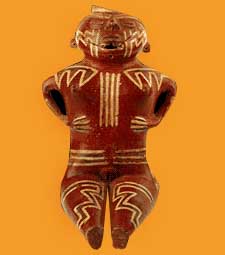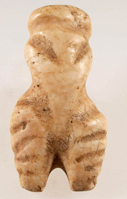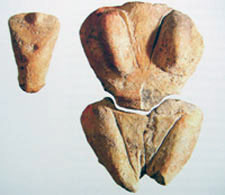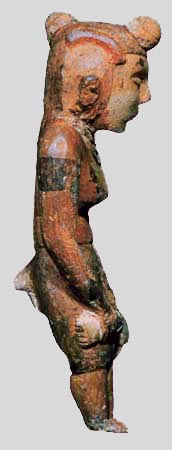
Condorhuasi culture, Argentina

Stone woman. Pietrele, Romania

Abstract female stone,
neolithic Sudan

Clay figurines from Skorba, Malta

From ancient Illinois
Female Icons, Ancestral Mothers poster identifications, from top left:
Balzi Rossi, Italy. Paleolithic, carved ivory with painted ochre traces. Seven icons were found at this site in Liguria, northwestern Italy.
El Kadada, Sudan. 5th millennium bce. Clay figurine with lines highlighting hips and vulva (head broken off).
Badarian period, Egypt. Ivory figurine with lapis lazuli inlaid eyes, sometime in the 4th millennium bce. Many figurines of this era were placed in burials.
Kostienki, Russia. One of many paleolithic statuettes of women from this region.
Valdivia, Ecuador. The oldest known female figurines in South American, starting from circa 4500 BCE in stone and continuing for thousands of years in clay, often painted with red ochre as in this example
Mal'ta, Siberia. This paleolithic site near lake Baikal has yielded numerous divine women carved in mammoth ivory.
Courbet, France. Paleolithic abstract carving of a woman from the Tarn region of southern France.
Tan Tan, Morocco. I've seen the carved enhancements on this natural rock dated to anywhere between 70,000 to 200,000 years old.
Coastal Alaska. The ancient Punuk culture carved many of these images in sea mammal ivory and bone.
Jomon culture, Japan. Tens of thousands of female figurines have been found from this ancient aboriginal culture, ancestors of the Ainu people. This stout woman is classified with a group with mountain-shaped heads.
Nok, Nigeria. This is one of the stunning ceramic sculptures of the Nok culture, which flowered between 500 bce and 500 ce (common era) and shows clear signs of influence over later Yoruba sculpture.
Merhgarh, Pakistan. An important site that goes back to the pre-pottery neolithic, into the 8th millennium bce; successive layers of villages produced predominantly female icons over thousands of years.
Karanovo, Bulgaria. An abstract female carved in green stone, with the vulva emphasized and shimmering with numinous points, circa 5500 bce.
Puebla, Mexico. One of the myriad ancient clay women from the Mexican plateau in the "pre-Classic" period, a classic tradition all its own.
Niuheliang, China. From the sacred grounds of what Chinese archaeologists call the "female spirit temple" in northeastern China, in the late 5th millennium bce. Life-sized unfired female sculptures were found in this funerary-ancestral shrine but excavation has been postponed pending development of a method of extracting them without destroying them.
Zimbabwe. These figurines from the early centuries CE in southeastern Africa were very hard to find, and represent one of the most hidden (that is, unpublicized) cultural histories.
Amur river, Manchuria. This statuette comes from a culture that created beautiful pots with incised spirals or with female masks around 5000 years ago.
Samarra, Iraq. This clay figurine was already thousands of years old when the Sumerian civilization arose, and is one of countless female icons from neolithic Iraq.
Tepe Hissar, Iran. A highly abstracted woman sculptured in alabaster.
Paracas, Peru. A funerary figurine from southern Peru, dating to about 500 bce.
Hacilar, Turkey. One of many female figurines circa 5000 BCE.
Range Creek Canyon, Utah. The most stunning example of what archaeologists call the "Fremont" culture (no indigenous name available at this writing) that flourished between 700-1300 ce.
Marajo, Brazil. This important cultural center on an island at the mouth of the Amazon river had a rich cultural heritage including large mound sanctuaries, clay statutes and magnificent painted or incised ceramic vessels.
Sé, Hungary. A highly abstracted female figurine in clay, probably originally with a long neck, circa 5000 bce.
Lake Chad, north-central Africa. One of the clay sculptures of the Sao people around 1000 years ago.
Mohenjo Daro, India. Or at least it was called India for thousands of years, after the Indus river, now known as Pakistan. Hundreds of clay women were found at this city dating to about 2500 bce, often coated with red ochre, as here.
Greenland, north Atlantic. This sea-mammal ivory sculpture is described as belonging to the Dorset culture, sometime before 1200 ce.
Chupícuaro, Mexico. These vividly glazed figurines from southeast Guanajuato often show fat women with hands on belly. This one dates circa 300-100 bce.
Ulua valley, Honduras. A site with the modern name of Playa de los Muertos has yielded rich clay sculptures of seated women, dating circa 1000 to 550 bce.
Argentina. Reddish hollow female figurines from the Condorhuasi culture are richly painted with patterns which reflect the ancient South American tradition of ritual body-painting.
Gower, Britain. A small figurine, apparently cast metal, of archaic type but probably dating to Roman-Briton times.
Israel. "Pillar figurines" of women holding their breasts are found in Israel, Jordan, and Gaza, and most were created around 900-700 bce, though some may be earlier as others could date as late as 500 bce. Some are entirely handmade, while others like this example have mold-made heads.
Chile. A clay figurine of a woman with a snakelike hood around her head.
Jamacoaque culture, Ecuador. A sophisticated ceramic sculpture tradition, characterized by joyous faces and shamanic features, developed from around 400 bce and continued for over a thousand years.
Costa Rica. This image from the Museum of the American Indian (1976) was undated. Possibly from the Nicoya-Guanacaste culture.
El Salvador. No date or place given in source.
Illinois. This represents an indigenous American tradition poorly documented although of great historical importance, usually identified as the "Hopewell" culture after a settler's farm. I believe it to be from Illinois, where other figurines in similar seated style are found, and took the picture in the Field Museum, Chicago, but the "Hopewell" site is in Ohio. Just another indicator of the problematics around naming.
Tepe Gawra, Kurdistan (northern Iraq). An important ancient site with a long history; this example with the dramatic flaring eyes belongs to the Halafian cultural wave that started in Syria and spread into Iraq and the Levant.
Sulawesi (used to be called Celebes). Female figurine (paired with a male) from an island in eastern Indonesia, due south of the Philippines. No date given.
Poverty Point, Louisiana. A very important ancient site in the lower Mississippi basin, dating back some 35 centuries. In addition to the many female figurines and animal images, it has a major mound complex with geo-astronomical significance, laid out in semi-circular rows.
Bananal Island, Brazil. An early Karajá female figurine from the large island in the Xingu river, south of the Amazon. This one wears a loincloth of red fibers, which are sometimes tied as tassels to other figurines.
Kenya/Uganda borderlands. No date or other information given in source.
Georgia (the state in North American, not the country in western Asia). Another museum shot with virtually nil information. Possibly Cherokee? Yuchi?
Halfa Degheim, Sudan. Variously dated from 4000 to 3200 bce, this clay statuette emphasizes the vulva and hips with radiating wavy lines. So-called "A-Group" culture. Couldn't they think of a better name?
--Max Dashu
Suppressed Histories Archives | Articles